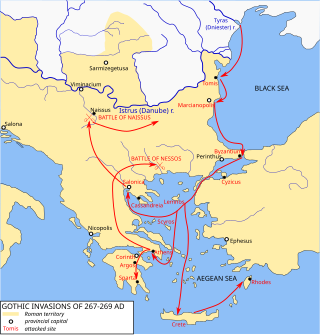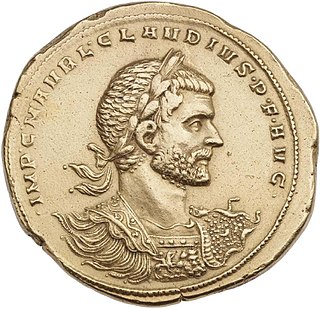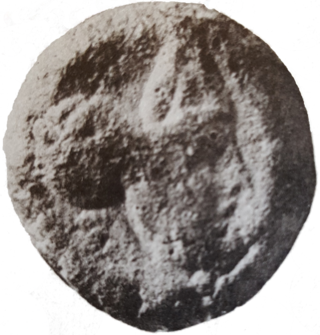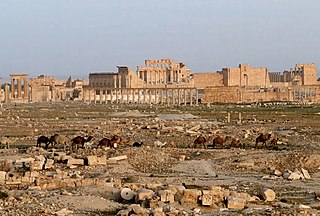
Publius Licinius Egnatius Gallienus was Roman emperor with his father Valerian from 253 to 260 and alone from 260 to 268. He ruled during the Crisis of the Third Century that nearly caused the collapse of the empire. He won numerous military victories against usurpers and Germanic tribes, but was unable to prevent the secession of important provinces. His 15-year reign was the longest in half a century.
The 260s decade ran from January 1, 260, to December 31, 269.

Septimia Zenobia was a third-century queen of the Palmyrene Empire in Syria. Many legends surround her ancestry; she was probably not a commoner and she married the ruler of the city, Odaenathus. Her husband became king in 260, elevating Palmyra to supreme power in the Near East by defeating the Sasanian Empire of Persia and stabilizing the Roman East. After Odaenathus' assassination, Zenobia became the regent of her son Vaballathus and held de facto power throughout his reign.

Year 267 (CCLXVII) was a common year starting on Tuesday of the Julian calendar. At the time, it was known as the Year of the Consulship of Paternus and Arcesilaus. The denomination 267 for this year has been used since the early medieval period, when the Anno Domini calendar era became the prevalent method in Europe for naming years.

Marcus Aurelius Claudius "Gothicus", also known as Claudius II, was Roman emperor from 268 to 270. During his reign he fought successfully against the Alemanni and decisively defeated the Goths at the Battle of Naissus. He died after succumbing to a "pestilence", possibly the Plague of Cyprian that had ravaged the provinces of the Empire.

Septimius Odaenathus was the founder king (Mlk) of the Palmyrene Kingdom who ruled from Palmyra, Syria. He elevated the status of his kingdom from a regional center subordinate to Rome into a formidable state in the Near East. Odaenathus was born into an aristocratic Palmyrene family that had received Roman citizenship in the 190s under the Severan dynasty. He was the son of Hairan, the descendant of Nasor. The circumstances surrounding his rise are ambiguous; he became the lord (ras) of the city, a position created for him, as early as the 240s and by 258, he was styled a consularis, indicating a high status in the Roman Empire.
Balista or Ballista, also known in the sources with the name of "Callistus", was one of the Thirty Tyrants of the controversial Historia Augusta, and supported the rebellion of the Macriani against Emperor Gallienus.

Septimius Vaballathus was emperor of the Palmyrene Empire centred at Palmyra in the region of Syria. He came to power as a child under his regent mother Zenobia, who led a revolt against the Roman Empire and formed the independent Palmyrene Empire.

The Palmyrene Empire was a short-lived breakaway state from the Roman Empire resulting from the Crisis of the Third Century. Named after its capital city, Palmyra, it encompassed the Roman provinces of Syria Palaestina, Arabia Petraea, and Egypt, as well as large parts of Asia Minor.
Zabdas was a 3rd-century Syrian general who led the forces of Empress Zenobia of Palmyra during her rule as regent of her son Vaballathus and her subsequent rebellion against the Roman Emperor under the short-lived independent Palmyrene Empire. He led Palmyra's expeditions in the middle east which included annexing territory spanning from Roman Egypt to Asia Minor.

Maeonius, or Maconius, was a usurper who, according to the Historia Augusta, briefly ruled over Palmyra. He is included in the list of the Thirty Tyrants.
Marcus(?) Aurelius Heraclianus was a Roman soldier who rose to the rank of Praetorian Prefect in the latter part of the reign of the Emperor Gallienus. He was a member of the cabal of senior commanders of the Imperial field army that plotted and achieved the assassination of the Emperor Gallienus. His subsequent fate is uncertain. The only ancient reference has him committing suicide, but the circumstances are unclear.
Septimius Antiochus was a Roman usurper in Syria during the 3rd century.

Palmyra is an ancient city in the eastern part of the Levant, now in the center of modern Syria. Archaeological finds date back to the Neolithic period, and documents first mention the city in the early second millennium BC. Palmyra changed hands on a number of occasions between different empires before becoming a subject of the Roman Empire in the first century AD.
Septimius Orodes was a Palmyrene official and a viceroy for king Odaenathus of Palmyra. He was given the surname Septimius by his monarch.

Septimius Herodianus or Hairan I was a son and co-king of Odaenathus of Palmyra. Through his father's marriage to Zenobia, Hairan I had two half-brothers, Hairan II and Vaballathus.
Septimius Haddudan was a 3rd-century Palmyrene official, the only known Palmyrene senator other than Odaenathus, and a priest and symposiarch of the god Bel, who is known to have opposed the rule of Queen Zenobia of Palmyra and aided the Roman Empire during their wars against the queen.

Odaenathus, the king of Palmyra from 260 to 267 CE, has been identified by modern scholars as the subject of sculptures, seal impressions, and mosaic pieces. His city was part of the Roman Empire, and he came to dominate the Roman East when in 260 he defeated Shapur I, the Sasanian emperor of Persia, who had invaded the Roman Empire. Odaenathus besieged the Sasanian capital Ctesiphon in 263, and although the city did not fall, the campaign led to a full restoration of Roman provinces taken by Shapur I. In the aftermath of his Persian war, Odaenathus assumed the title King of Kings, which was a challenge to the Persian monarch's claims of authority in the region. Odaenathus ruled the Roman East unopposed with imperial consent. In 267, he was assassinated alongside his eldest son Herodianus while conducting a campaign against Germanic raiders in Bithynia; he was succeeded by his son Vaballathus under the regency of the widow queen Zenobia.
Timolaus of Palmyra was reportedly a 3rd century Palmyrene nobleman, son of the king of kings Odaenathus and augustus Zenobia. Little is known about him, and all the existing information comes from speculation. Such is the doubt of his existence that some scholars try to associate him with Vaballathus, another of the sons of Odaenathus and Zenobia. Some authors believe he is an individual made up by the Historia Augusta, the only historical source that cites him, and some speculate that he is in fact a historical figure. He appears only in 267, at the time of his father's assassination.












